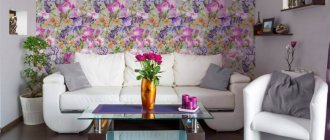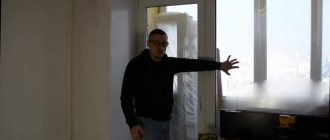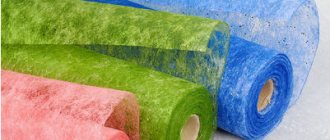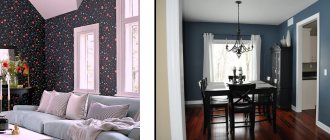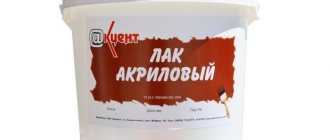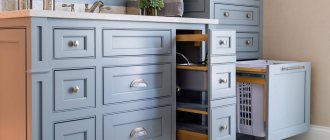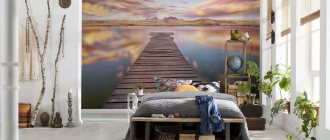Decorating the interior of a home using paper wallpaper is far from a new word in construction and architectural design. Due to the fact that this material is supplied ready-made, inexperienced buyers mistakenly believe that the gluing procedure does not contain any pitfalls. However, for beginners, the process of applying paper rolls to ceilings and walls comes with many unfamiliar challenges. One of them is the problem of how to glue wallpaper in corners and at the joints of different surfaces so that they adhere reliably and maintain a presentable appearance. Due to the fact that the geometry of the room may differ from a standard square room with right angles, its cladding will require compliance with the appropriate rules and techniques.
From what angle to glue
When you first take on the task of decorating an apartment yourself, you may get confused already in the first steps, when in front of you there is only a bare wall. Beginners ask questions about which side to put the first roll on correctly and whether the direction in which you move during the gluing process plays a role. Experienced users confirm that first of all you need to complete wallpapering the ceiling if you do not intend to finish it using another method. Once you're done with the hardest-to-reach surface, it'll be easier to focus on the adjacent walls without worrying about accidentally touching the fresh wallpaper. At the same time, both the ceiling and the walls require individual approaches to the selection of areas and direction for starting gluing. Wrong decisions at this stage will seriously complicate further finishing work, especially if you have no experience. Recommendations for solving this issue with your own hands are as follows:
- On the wall. When it comes to lap adhesive, the only correct choice is to apply the first strip near the window. This is done so that in the light of the sun the seams between them are not visible. In the case of wallpapering end-to-end, in addition to the window, starting positions are allowed at door frames and corners. Also take into account if the design of your facing panels includes drawings or complex patterns, which must match those on adjacent strips.
- On the ceiling. With this surface the problem is easier to solve, because All experts unanimously point to the need to glue the first roll strictly in the center of the ceiling. This way, it will be possible to adjust the remaining canvases so that they go symmetrically to the walls on either side of the central one.
Docking methods
Joining canvases when gluing is considered the most complex process, and for its organization there are the following joint options:
- straight;
- displaced;
- arbitrary;
- using an additional element.
Let's start with the offset docking and find out what it means. This method of joining rolled material is considered the easiest. Its meaning is to shift the next strip onto the previous one so that an overlap forms on half of the pattern element. As a rule, the overlap is one to two centimeters.
Now let's look at an arbitrary (free) joining of wallpaper to find out what it is. The main feature is that it is allowed to use straight joints or provide overlap.
The method is suitable for working with wallpaper material that does not have a bright pattern.
Additional elements in the form of plastic overlays and wooden trims are used when joining different wallpaper fabrics, covering the seam areas.
Let's move on to the main question - direct docking - what is it? This option is well-deservedly popular; its meaning implies the correct connection of the canvases closely, without creating overlaps or gaps.
The question “what does direct docking mean?” occurs frequently. The method has certain difficulties, because the decorative layer should not have visible seams.
How to glue wallpaper end to end? The two canvases are compared, their vertical position is checked, the seam should be uniform, without discrepancies or gaps.
Features of wallpapering from different materials
In addition to the location of the main strip, the material underlying your wallpaper makes its own changes to the procedure for pasting a room. If in the past the only similar facing products were paper rolls, then the modern assortment of construction stores is noticeably richer. Several varieties of wallpaper have appeared on sale, the differences between which are not only in appearance, but also in technical characteristics. This is also reflected in the technology of gluing them:
- Paper. This material provides products with a minimum thickness, which requires gluing them to the surface immediately after treatment with an adhesive composition. Otherwise, the canvases may have time to get wet, which will affect their appearance and structural integrity.
- Vinyl. Moisture-resistant analogues are available with a relief surface, which gives them aesthetic properties and masks uneven walls. Before gluing, both the rolls of wallpaper and the surface to be glued should be treated with glue, and then allowed to dry - wallpaper for 10 minutes, walls for 15 minutes.
- Glass wallpaper. They got their name due to their high strength and the use of reinforcing components in the composition at the manufacturing stage. This provided the glass wallpaper with a high weight, which requires the selection of a special adhesive mixture and its preliminary application to the wall.
- Photo wallpaper. Due to their appearance, they require careful planning before gluing. In order for photo fragments on different strips to look harmonious on the wall, the latter needs preliminary marking. The rolls of photo wallpaper themselves need to be laid out in front of you in the correct sequence so as not to confuse the stripes.
- Non-woven. Moisture-resistant products with mineral fibers in the structure and an adhesive mixture on the inside, which does not require treatment with an adhesive composition. It is enough to apply the latter to the wall or ceiling, leaving it to dry for 15 minutes before applying the main strip.
- Fabric. These expensive canvases, like glass ones, require the use of special glue used in conjunction with fabric materials. The mixture is applied to the inside of the wallpaper and absorbed for five minutes. Gluing the fabric rolls themselves involves not only laying them on the surface, but also passing over them with a soft roller wrapped in a rag or towel. Beware of the formation of wrinkles, which often occur in such wallpaper due to the softness of the material.
Work order
It is best to start gluing wallpaper from the least visible point. Using a plumb line and a pencil, we mark a gluing line perpendicular to the floor. We set the first strip as accurately as possible, because most modern materials are attached end-to-end, without overlap. If you glue the first sheet unevenly, all subsequent sheets will lie skewed. To avoid mistakes, it is recommended to draw guide lines for each strip on the walls.
USEFUL INFORMATION: Improved wall plaster: we follow the requirements of SNiP
Advice: do not start gluing wallpaper from the corner; to begin work, select a flat part of the wall.
Experts have their own secrets for gluing corner elements.
- We glue with an overlap. When gluing wallpaper end-to-end in a corner, there is a risk that the sheets will diverge after drying and a gap will appear that cannot be eliminated unnoticed.
- We do not glue the whole canvas, even if the corner is perfectly even. Otherwise, after drying, folds and distortions will almost inevitably form.
- Coat the wall with glue. It is in the corners that the probability of material falling behind is especially high, so this rule applies to all types of canvases: paper, non-woven, vinyl.
Required materials and tools
Before you begin wallpapering, make sure you have all the necessary equipment on hand. Required tools include:
- Pressing spatula;
- Synthetic fiber roller;
- Roller for wallpaper seams, standard or conical (for vinyl);
- Stationery scissors for trimming wallpaper;
- Knife with a break-off blade;
- Plumb line for marking;
- Wallpaper brush;
- Painting spatula;
- Painting tray for preparing the adhesive mixture;
- Maklovitsa for applying glue;
- Measuring instrument – tape measure, stationery or folding ruler.
How to join wallpaper at corners?
The following algorithm will help you correctly paste wallpaper in the corners.
- Preparing the corner. Such work is carried out when plastering walls. Special plastic corners are installed in the corner of the wall. They are attached to putty. Next, alignment is carried out.
- Wallpapering corners. If the wall is uneven, trimming it in the corner will help preserve the pattern on the canvas. The corner area is smeared with glue. They start gluing from top to bottom from left to right.
- Leveling the canvas. Responsible leveling of the canvas on the wall will help get rid of defects and achieve good adhesion to the surface. The joint should not be more than 5 mm. After the wallpaper is glued, the remainder, if any, is cut off with a stationery knife.
How to properly prepare a corner for pasting
At the stage of preparatory work, the corner, like other surfaces, must be cleaned of dirt, dust and remnants of the previous finishing layer. The latter is removed entirely with a scraper, including old wallpaper, traces of whitewash, plaster or a layer of paint. If there are unevenness in the corner, such as chips, pits or cracks, surface treatment is required to level it. For this purpose, primer mixtures are used, which are evenly applied over its entire area to ensure high-quality adhesion to future wallpaper. The process will require professional tools in the form of an appropriate paint roller and a priming brush in order to reach those hard-to-reach narrow areas. After finishing the surface treatment, you need to let the primer dry, which will take from 1 to 12 hours, depending on the brand of the mixture used. The latter can be clarified by reading the manufacturer’s instructions on the packaging of the composition.
How to fix such defects?
The resulting joints in the wallpaper can be corrected. There are several ways to do this. It is very convenient if the wallpaper is paintable. In this case, the knocks can be treated with sealant, then painted to match the selected wall color. But it is better to carry out such manipulations before painting the wallpaper.
Attention! Experts do not recommend using putty for this, as over time it will begin to crack and crumble.
Bubbles and places that have come off
To carefully glue the joints of wallpaper that have come off in places or bubbles, for these purposes we take a 5 cc syringe. We put PVA glue into it, but you just need to first check its passage through the needle. If necessary, dilute with water. Work on gluing wallpaper is carried out in such a way that the needle does not stick into the wall and does not become clogged. It is important to saturate the wallpaper with glue and give it time to soak and then press it.
How to glue wallpaper joints
If the situation is more complicated and it is necessary to re-glue the joints, you will have to prepare some tools and materials. For this work you will need a spray bottle, a brush, a brush, a rubber roller, glue and warm water. First of all, you need to moisten the edges of the sheets and carefully pull them together.
After a few minutes, they will absorb moisture, and then PVA glue can be applied. Then you should level the joint areas and run a rubber roller over them. And, of course, smooth out the resulting wrinkles and air bubbles. As you know, all paper wallpaper can be deformed, so you should not get the paper too wet, otherwise it will simply tear or be unevenly distributed.
Sufficient hydration
Regarding vinyl or non-woven wallpaper, it should be noted that after drying they shrink greatly, returning to their original appearance. In this case, you will need to moisten the back of the edges that are supposed to be re-glued. In this case, you can use a rubber roller, which does not stretch the paper, but only presses it against the wall surface.
It is important to take into account that before gluing the wallpaper, you must wet it. Please note that the more the wallpaper gets wet, the wider it becomes. This will help you align the wallpaper correctly.
Sandpaper
There are other ways to seal joints that are used for more serious damage. First, you need to rub the front side of the scraps remaining after work with sandpaper. Next, you need to take the tinting paste and dilute it with PVA glue. To mask the resulting gap, you should cover it with the resulting paste. This must be done very carefully. The paste can be the same color as the wallpaper.
It is also possible that the edges turn out darker due to the fact that the rolls are from different batches or that a defective product was simply purchased. Therefore, you need to be very careful when purchasing and look at the ends of the rolls.
Patches and inserts
There is another method for hiding joints on wallpaper. But using it as an option is not suitable for all types of wallpaper. You can make “patches” from the remaining pieces of wallpaper and paste them as artificial joints. To do this, you need to cut the patches and connect them to the edges of the wallpaper. It is important to accurately match the pattern of the wallpaper and the pattern of the finished patch.
It is important to maintain the soaking time of the sheet so that the sheet does not swell too much. When cutting, it is better to use a good, even spatula and an upholstery knife with a new blade.
If you do everything very carefully, the result will be good.
Learn more about wallpaper restoration.
Paper borders
But you can do it differently. If you have some imagination, you can use paper borders. The main task in this case is the selection of the border itself, which will be suitable both in color and in structure and material used in its production. You can also disguise areas of discrepancies with all kinds of ribbons and curtains. And then make, for example, a frame for a photograph or painting from the same material. It will turn out very beautiful and original. No one will even understand that this was done later; everyone will assume that initially everything was intended to be so.
Be wary of pencils and markers; if applied too hard, the pigment may bleed through the wallpaper.
Currently, there are many technologies that can be used to correct various wall defects, including gaps formed between sheets of wallpaper. But it is better to immediately adhere to all the rules when carrying out work and take into account all the features of the acquired type of wallpaper, than to later look for ways to hide the joints or make them invisible. Write your wallpaper repair options in the comments.
Step-by-step instructions for wallpapering corners
Internal corner
Depending on the type of wallpaper chosen, it may be necessary to pre-apply adhesive to the surface of the adjacent walls. This can be done using a synthetic roller, lubricating it with an adhesive mixture from a paint bath and “walking” it over all surfaces that will be sealed. In the deepest corners, where the roller cannot reach, you should use a brush and also thoroughly coat everything with glue. Try not to apply too large volumes of the mixture to avoid the formation of smudges, which can cause bubbles to appear under thin rolls of wallpaper. Make sure that there is an even layer of adhesive in all areas.
If you are using canvases that do not need to be treated with an adhesive composition on the surface of the walls, skip this step and proceed to cladding.
To harmoniously apply wallpaper in the inner corners, experts recommend using the method of cutting the roll to the desired thickness. The goal is that it can be applied in a strip that will cover the entire corner and extend onto the adjacent wall by no more than 50 mm. To prevent this from being visible in the future, a strip of wallpaper on the adjacent wall needs to be glued overlapping and closed with it to cover the resulting seam. If you notice that two layers of wallpaper do not fit on the corner, you should use a different method. Using a break-blade knife, make a straight, vertical cut around the perimeter of the corner so that it goes evenly through both layers of sheets. To prevent the cutting line from moving, you can press the strip with a level, rule, or strong ruler, along which it is convenient to guide with a knife blade.
External corner
Otherwise, a preliminary calculation of the length of the wallpaper strips takes place, taking into account the spare distance in order to go around the outer corner without loss. Exceptions include examples of the use of wallpaper with a high density of material. It is not always possible to bend these without loss of appearance and integrity. Therefore, a knife is again used to cut a strip up to 6 mm thick from the edge of the canvas, which will be laid over the seam between two scraps on the adjacent walls of the outer corner.
Wallpapering with a pattern
The task of pasting corners is even more difficult if the wallpaper is decorated not with a matte monochromatic color, but with decorative images, be it drawings or photographs. In this case, an unsuccessful “passing” of the corner can disrupt the composition and significantly spoil the appearance of the room’s interior. The reason for such difficulties is the use of the method of overlapping the edge of a corner strip of wallpaper with an adjacent overlapping trim, which displaces the image. This gluing technology is also used here, but requires increased care in order not to spoil the appearance of the products.
An “alternative solution” involves planning the room in such a way that the area with the damaged image is covered by a large interior object such as a wardrobe or wall.
Detailed instructions for gluing internal corners
When performing finishing work, uneven walls can be a serious problem, which can cause wrinkles to form when gluing wallpaper. If the walls have a curvature, then as a result the wallpaper sheets may not fit together and will diverge:
- Having glued the last sheet in front of the inner corner, the length of the un-glued area is then determined. It is necessary to measure the distance starting from the edge of the glued canvas and to the boundary wall. Next you need to add about 10-15 millimeters to the result obtained. If the walls are strongly curved, you need to increase the number of additional millimeters.
- Cut a strip of wallpaper equal to the calculated result.
- Carefully treat the surface of the wallpaper and the wall. Based on the type of coating, you can treat two surfaces at once or just the wall.
- The cut part of the wallpaper strip should be located towards the wall. The canvas should be located on two planes at once.
- When wrinkling pasted wallpaper, you need to make a couple of perpendicular cuts to the folds.
- Using a level on the boundary wall, you need to draw a line vertically. It should be located at a distance equal to the width of the previously cut web, without taking into account additional additives.
- Lubricate the surfaces with glue, then place an even part of the wallpaper to the drawn line, and the cut part should go to the adjacent side.
- If the coating is thick, the wallpaper must be cut along the superimposed line.
Working with uneven corners
The previous methods work well with standard right angles, but you may encounter less traditional geometries in your space. Then you can overcome the curved corner using the following instructions:
- The height of the wall is measured and 7 cm is added to the resulting value.
- The wallpaper roll is cut into several strips with the required thickness and in the appropriate quantity. If the canvases contain a pattern, take this into account and take fragments from their edges to minimize damage to the composition.
- We treat the walls and corners with glue, if required for the selected brand of wallpaper. Otherwise, apply the adhesive mixture only to the inside of the strips and glue them to the corner. At this stage, there will inevitably be some bumps, which you shouldn’t be afraid of, because... in the future they can be corrected by cutting off unnecessary fragments.
- To avoid “blockages”, you should carefully press the sheets along the entire perimeter of the corner, expelling air accumulations from under them. This will ensure better adhesion of facing products to the surface.
- The corner section with two layers of wallpaper overlapped is carefully trimmed with a knife. After that, the resulting cut is also treated with an adhesive mixture, on top of which a folded fragment of the strip is placed.
We work with non-woven material
We found out what direct joining of wallpaper 64 means - this is a way to get a seamless wall surface. To better understand how to perform such a task, let’s consider the process using non-woven wallpaper as an example.
Let us briefly recall the advantages of canvases:
- differ in tensile strength;
- do not ignite;
- retain thermal energy in the room, protect from extraneous sounds;
- not susceptible to ultraviolet radiation;
- differ in reasonable cost.
Let's figure out how to hang non-woven wallpaper without seams.
To begin with, vertical markings are made on the wall. In this case, a fifteen-centimeter indentation is made from the corner plot.
If the wallpaper material does not have a bright pattern, it is allowed to cut several strips.
Turning them face down, coat them with glue one by one and allow time for impregnation. We lay the canvas on the surface, smooth it from the ceiling to the sides, squeezing out the air.
How to properly join non-woven wallpaper? We apply the next strip to the glued strip exactly along the joint, and carefully move it over the area with a spatula.
How to combine wallpaper with a pattern? The combination of patterns is checked when cutting the canvases. It is possible that the stripes will come out with a certain margin, which is cut off after the glue has dried.
To adjust the pattern, there are several joining methods:
- offset - the picture is shifted by half, the installation resembles a chess board;
- loose – does not require adjustment, the designs look chaotic;
- counter docking - what is it? The material is adjusted by oppositely gluing the next strip to the previous one;
- repeat pattern - repeating patterns require adjustment and repetition through each stripe, because they are present on all the walls of the room. The repeatability of the pattern gives the walls a sense of continuity.
- shifted alignment is used to adjust the next canvas with a vertical shift;
- What does direct joining of wallpaper 64 cm wide mean? This refers to canvases combined at the same height with direct application of the pattern.
Wallpaper with a pattern
The presence of a pattern on the wallpaper complicates the process of pasting both corners and walls. In the presence of vertical lines, distortions in the corners of the room immediately catch the eye; with horizontal patterns, there is an overlap of the canvases or a skew in the ratio of the ceiling to the floor.
The following tips will help you avoid such troubles:
- it is necessary to make a slight overlap on the previous canvas;
- if a curvature has formed, you need to move it to the upper part, then hide it behind the panels;
- The smooth edge must be glued plumb, the excess part must be cut off using a stationery knife.
Following these tips will help minimize curvature and make the wallpaper fit together more successfully.

